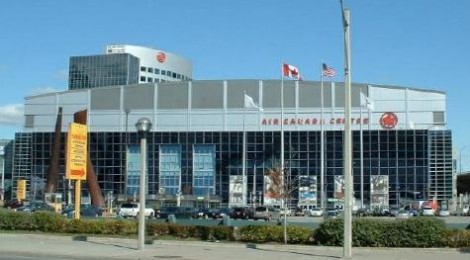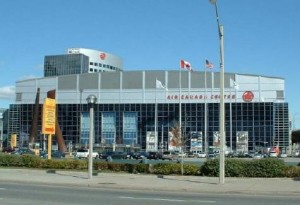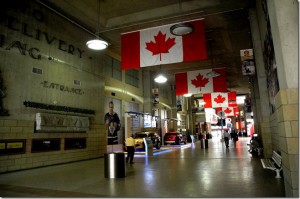
Site Analysis – Air Canada Centre
Site – Air Canada Centre
Location – 40 Bay Street

Outside the Air Canada Centre
(Photo taken from http://www.dougloudenback.com/hornets/TorontoArena.htm)
For my site analysis, the location that I selected was the Air Canada Centre (ACC),which is owned by Maple Leaf Sports & Entertainment Ltd. (MLSE). The Air Canada Centre is a sports and entertainment complex and stadium/arena located downtown Toronto at 40 Bay Street, which is at the northwest corner of Lakeshore Blvd. West and Bay St. It the home location for Toronto Maple Leafs of the National Hockey League (NHL), Toronto Raptors Basketball Club of the National Basketball Association (NBA) and the Toronto Rock Lacrosse of the National Lacrosse League (NLL). The ACC is more than the home to some Toronto sport teams as it is also the frequent place where concerts, shows, business trade shows, circuses, public events, private functions and more sporting events take place. This is a location visited by millions of people yearly and whenever at this place, there are always diverse sounds and noises being heard. It is shown through the huge seating capacity that the venue can hold for events that these seats are being filled with cheering fans. For example the seating ability for basketball is 19,800 seats, hockey is 18,800 seats, a concert is 19,800 seats and the theatre can hold 5,200 viewers (Facts – The Air Canada Centre). The ACC is also in a location that attracts many people as it is situated in downtown Toronto where nearby transportation accommodations are available. From Union Station which has the subway and GO trains, there is a walk way connecting spectators to the ACC. Also it is a short distance away from the Gardiner Expressway where drivers can park in one of the over 13,000 parking spaces all that are within walking proximity (Viccari,1999).

Toronto’s main Postal Delivery Building 1944.
Photo taken from http://tayloronhistory.com/2013/02/12/torontos-architectural-gemsthe-postal-delivery-building-now-the-acc/)
The history of 40 Bay Street started in 1834, when site plans presented two waterfront constructions spreading into the lake from Front St. which is currently the Air Canada Centre. In the 1850s, the Jacques and Hayes Wharf structure was built, also in that period, furniture makers had a factory in what is today Union Station. A name change was made to the Wharf to being called Worthington’s Wharf but in 1882, the structure got ruined by a fire. The first structure created on the lands of the Air Canada Centre was the Cobban Building in 1884. It was a four floor structure which was linked to the city of Toronto by an elevated bridge spreading to York Street. The Cobban Building functioned as a building for foundry operations by Phillips Manufacturing and then, A.R. Williams Machinery. Destroyed in 1931, was the Cobban Building but in 1939, the formation of the Toronto Postal Delivery Building started with drawing designs done by Charles Dolphin, a Toronto architect working along Charles Sutherland. Creation for the Toronto Postal Delivery Building started on 1939, with it being finished in 1941. For the period of World War II, in 1939-1945, the postal building was the Department of National Defense with an added rooftop being done after the war in 1946-1949. With construction of the Gardiner Expressway in the 1960s, it extended to the bag storing section of the postal delivery building taking away the garage for parcels (A quick history of 40 bay st, 1999).

The north wall of the Postal Delivery Building on the left-hand side as seen in the inside of the ACC .
(Photo taken from http://tayloronhistory.com/2013/02/12/torontos-architectural-gemsthe-postal-delivery-building-now-the-acc/)
As part of the first NBA spreading out offer, the Toronto Raptors chose to create a new location for themselves in 1993, and in 1994, the Raptors proclaimed interest in the site of 40 Bay St. With the help of Air Canada who made a naming partnership with the Raptors in 1995, they bought the land from the Toronto Postal Delivery Building. Still preserved are south and east walls of the postal building that were not touched when the tearing down of the postal building was done in February, 1997, to get ready for the making of the Air Canada Centre. April, 1997 marked the day when the first concrete got poured for the ACC and in February, 1998, the Toronto Raptors and the Air Canada Centre got bought by Maple Leaf Gardens (A quick history of 40 bay st., 1999). At the ACC, the very first ice was completed on December 28, 1998, and the Toronto Maple Leafs had their first practice on that ice January 5, 1999. The 665,000 square foot Air Canada Centre opened February 19, 1999. The Toronto Maple Leafs hosted their first hockey game February 20, 1999, while the Toronto Raptors was the home team on the next day February 21, 1999, at the Air Canada Centre; they both won their very first game at the stadium. Canadian band The Tragically Hip on February 22, 1999, performed a sell-out concert for the first concert held at the Air Canada Centre. At the ACC, the roof is 40 feet directly above the current facades, and was made to be flat, providing the look of a hangar. This permits enhanced sound quality inside and a noticeable city existence outside without hindering the sight of other milestone structures. (History – The Air Canada Centre).
The construction budget for the Raptors was $217 million but when the Leafs made up their minds on what modifications and add-ons they wanted, $48 million was added totaling $265 as the cost of the Air Canada Centre. Brisbin, Brook and Beynon Architects, a Toronto corporation were the ones who initially designed the ACC, but the Leafs got HOK, a Kansas City located architectural and design company to work with them. Modifications and add–ons were done with the help of builders from PCL Constructors Eastern Inc. (Shoalts, 1999).
In November 2005, Maple Leaf Square was announced from a partnership between Maple Leaf Sports & Entertainment Ltd., The Cadillac Fairview Corp. Ltd., and Lanterra Developments. The focal point of Maple Leaf Square is all the ample and environment friendly open space around a square for the public which is used to accompaniment events at the ACC, such as sporting events, concerts and shows. As Richard Peddie, president and CEO of Maple Leaf Sports & Entertainment, said, “Maple Leaf Square will be a vibrant and unique landmark that has a tasteful sports and entertainment theme reflective of the Leafs, Raptors and Air Canada Centre. Our development creates a larger significant stage that will attract major sports and world events to Toronto and at the same time support tourism and economic growth, (MLSE, Cadillac Fairview and Lanterra unveil major downtown development, 2005).” Some of the features of the Maple Leaf Square include a hotel, shops, restaurants, condos, a music club and broadcast studio (MLSE, Cadillac Fairview and Lanterra unveil major downtown development, 2005). The construction period for this started in the summer of 2008 (Westhead, 2005). In 2010, on the west side of the Air Canada Centre, Maple Leaf Square opened (MAPLE LEAF SPORTS & ENTERTAINMENT THANKS FANS WITH FREE PUBLIC SKATE, 2011).
The Air Canada Centre follows the idea established with BOSE Electronics that was used for the GM Centre in Vancouver, as Brain Brisbin of the centre’s architects, Brisbin, Brook, Beynon said “sound systems required for sports arenas and concerts are diametrically opposed. With the aid of BOSE engineers, we have reduced reverberation time to 2 1/2 seconds from 5 seconds, and have achieved an appreciably greater flexibility. Audiences for musical performances want better sound, and even so, you need to satisfy aficionados of rock groups as well as the Three Tenors, (Viccari,1999).” There is wheelchair accessibility at the ACC for the ones that need it in the middle level section accommodating 166 wheelchairs. Washrooms and food and beverage counters are also wheelchair accessible. There are more than 650 television screens within the ACC with countless situated in the washrooms and are used while all sporting events are going on and a few entertainment events. The main screen, the Jumbotron, is the extensive-screen shown that functions as the dominant television screen which shows messages and the score (Viccari,1999).
After the two part development done in 2008/2009, the ACC made a change in technology. There was a whole renovation of the auditory system in the main bowl, a complete technical advancement of the chief control room and its broadcast substructure, new audio parts for the stadium/arena in the west end development and Maple Leaf Square, and a not parallel mix among all the site’s system by a new network design. The new sound system allowed the ACC to make music services available to the clubs within the site and make the communication better and integration among areas such as the new Gate 5 broadcast studio, the bowl, and the dominant core of the control room. Courtney Ross, Head Audio Engineer at the ACC, made a comment about the sound in the whole building being controlled by the core control room, “It’s expanded everybody’s capabilities for communication. I have four main audio computers that tie into the communications systems. I can monitor any specific point, or zone, or club (Young, 2010).” Now controlling the sound will be easier to control and more improved and better quality for the spectators.
As Jonathan Sterne, mentions in Sounds like the Mall of America: Programmed Music and the Architectonics of Commercial Space, the Mall of American and places like that is more than just having a crowd in an unfilled area, the music turn out to be part of the dependability of that space. The sound becomes known and by being there it come to be a vital aspect of the location structure (1997). Sounds and music are employed at the Air Canada Centre to produce certain experiences and to encourage certain activities. The house sound system at the stadium/arena can extend to levels of 96 volumes, which can be equivalent to a 707 jet taking off 1,000 feet away ( Quick Fact – The Air Canada Centre). The separation among background and foreground music in Muzak and different kinds of programmed or ambient music is indistinct in today’s music (Hirsch, 2007). Depending on what people come to the ACC for, helps determine the background and foreground music. If attending a sports game the foreground noises are the sounds coming from the ice, the court or the field, it is the players and the action playing the sport with the while music is the background noise as the music takes away from the focus of the game. When attending a concert the music coming from the artist/performer is the foreground music as that is what people go to see while the background noises are coming from the audience.
Christopher Small says “music is not a thing at all but an activity, something that people do, (1998).” This is shown at the ACC as people will go to the ACC to watch a sports event, concert, or theatre show which becomes the activity and music becomes the thing that is involved in the activity that the spectators are seeing (1998). A fan wrote about their experience at the ACC on Yelp, a Toronto User Reviews and Recommendations. This fan shared that the ACC is their favourite stadium/arena because of where it is located in downtown Toronto and mentions how even if they cannot get tickets for Raptors or Leaf games, the game is aired on a huge screen outside the main entrance which they love. When seeing a concert at the Air Canada Centre, this fan says that it is “enjoyable, good sound quality and good enough view, (yelp.ca).” According to this fan time spent when at the ACC, whether inside or outside the stadium/arena the crowd helps create a musical experience with the sounds and noises (yelp.ca). In my interviews, when I asked Jacqueline about her overall experience at the ACC concerts, she descried it as a very nice building and atmosphere, there was a clear view where the lights, were not too bright or dull and everyone including herself was having a good time. When asked if sounds help produce a positive experience, her response was yes, the live singer/band was able to be heard clearly and make the audience get up from their seats and sing, dance and cheer (Jacqueline, 2013). Lianne, who usually goes to the Air Canada Centre for Leafs/Raptors sporting events shared her overall experience and the sound by saying how she loved it, and liked the sound, it help create a positive experience by the clear sound from the great system but since the crowd was loud, the sound system was overpowered at times (Lianne, 2013).
From being at the Air Canada Centre, sounds and music encourage certain activities and experiences but it is not the case when living too close to the stadium/ arena. On Digital Home, a Canadian TV, Computing and Home Theatre Forum, a person, who lives in a building nearby the ACC, wrote to find out what to do about a problem experienced. At the ACC, the sound of the horn is very noisy and this person can hear the sound of the horn from a goal before seeing the actual goal on television . They will know a goal is going to be scored as when sporting games are aired live they are being delayed on television. With the delay between the broadcasting of the game and being at the game this spoils the game for this fan as they know the Leafs are going to score before seeing it happen. A user responded to this forum by recommending a petition for a noise bylaw violation so that the Air Canada Centre would lower the sound of the horn (http://www.digitalhome.ca/). The sound of the horn that this fan experiences ruins watching Leaf games played at the Air Canada Centre from home. This discourages the activity of watching the game when it is aired on television and the experience of watching at home. This fan gets a different experience from all other viewers watching at home with the loud noise of the horn. From the suggestion about a noise complaint it can be related to the noise complaint from The “War on Noise”: Sound and Space in La Guardia’s New York reading. In December 4, 1939, in New York City, a couple conveyed a noise complaint to the court for supposedly disrespecting the city’s anti-noise order. It was over noise produced by concrete mixers, pile drivers, and steam derricks. At the court it had to be decided whether or not the noise/sounds heard was by- the couple was necessary or unnecessary noise from the construction. In the end, the court decided it was necessary noise. (Radovac, 2011) This can be related to what the hockey fan is experiencing as since they live in a building near the ACC; is the sounds of the horn from a home game goal scored necessary or unnecessary noise. It is necessary for the ones at the game but since there is a broadcasting delay when watching at home it is unnecessary to be heard at home.
Works Cited
G, Lianne. Personal interview. 25 Nov. 2013.
K, Jacqueline. Personal interview. 29 Nov. 2013.
“A quick history of 40 Bay St.: [1 Edition].” Toronto Star 19 Feb. 1999: 1. Canadian Newsstand Major Dailies. Web. 4 Dec. 2013.
“Air Canada Centre .” Yelp. N.p., n.d. Web. 29 Nov. 2013. <http://www.yelp.ca/biz/air-canada-centre-toronto>.
“Air Canada Centre, Home of the Toronto Raptors.” Air Canada Centre, Home of the Toronto Raptors. N.p., n.d. Web. 4 Dec. 2013. <http://www.dougloudenback.com/hornets/TorontoArena.htm>.
“Facts – The Air Canada Centre.” Facts – The Air Canada Centre. N.p., n.d. Web. 28 Nov. 2013. <http://www.theaircanadacentre.com/about/Facts.asp>.
Hirsch, Lily. “Weaponizing Classical Music: Crime Prevention and Symbolic Power in the Age of Repetition.” Journal of Popular Music Studies 19.4 (2007): 342-358. Wiley Online Library . Web. 4 Dec. 2013.
“History – The Air Canada Centre.” History – The Air Canada Centre. N.p., n.d. Web. 28 Nov. 2013. <http://www.theaircanadacentre.com/about/History.asp>.
“Living too close to Air Canada Centre – Canadian TV, Computing and Home Theatre Forums.” Canadian TV Computing and Home Theatre Forums RSS. N.p., n.d. Web. 29 Nov. 2013. <http://www.digitalhome.ca/forum/showthread.php?t=163457>.
“MAPLE LEAF SPORTS & ENTERTAINMENT THANKS FANS WITH FREE PUBLIC SKATE.” Canada NewsWire NO (2011): 1. CBCA Complete. Web. 4 Dec. 2013.
“MLSE, Cadillac Fairview and Lanterra unveil major downtown development.” Canada NewsWire NO (2005): 1. CBCA Complete. Web. 4 Dec. 2013.
“Quick Fact – The Air Canada Centre.” Quick Fact – The Air Canada Centre. N.p., n.d. Web. 29 Nov. 2013. <http://www.theaircanadacentre.com/quickfact.asp?fact_id=22>.
Radovac, Lilian. “The War on Noise: Sound and Space in La Guardia’s New York.” American Quarterly 63.3 (2011): n. pag. Project MUSE . Web. 4 Dec. 2013.
Shoalts, David. “Upgrades added to cost When MLSE bought the Raptors, the Air Canada Centre changed, too.” The Globe and Mail [Toronto] 17 Feb. 1999: C.2.. Canadian Newsstand Major Dailies. Web. 4 Dec. 2013.
Small, Christopher. “Prelude”.” Musicking: the meanings of performing and listening. Hanover: University Press of New England, 1998. 1-19. Print.
Sterne, Jonathan. “Sounds like the Mall of America: Programmed Music and the Architectonics of Commercial Space.” Ethnomusicology 41.1 (1997): 22-50 . JSTOR . Web. 4 Dec. 2013.
“Toronto’s architectural gems—the Postal Delivery Building, now the ACC | Historic Toronto.” Historic Toronto. N.p., n.d. Web. 4 Dec. 2013. <http://tayloronhistory.com/2013/02/12/torontos-architectural-gemsthe-postal-delivery-building-now-the-acc/>.
Viccari, Ben. “What you’ll see at ACC.” Performing Arts & Entertainment in Canada 32.2 (1999): 8-10. ProQuest Research Library. Web. 4 Dec. 2013.
Westhead, Rick. “Air Canada Centre facelift for arena’s 10th anniversary; $40 million job to begin in 2008 May add food court, playground: [MET Edition].” Toronto Star 27 Sept. 2005: E01.. Canadian Newsstand Major Dailies. Web. 4 Dec. 2013.
Young, Kevin. “A SOARING NEW SYSTEM FOR THE AIR CANADA CENTRE.” Professional Sound 21.1 (2010): 26-29. International Index to Music Periodicals Full Text. Web. 4 Dec. 2013.
